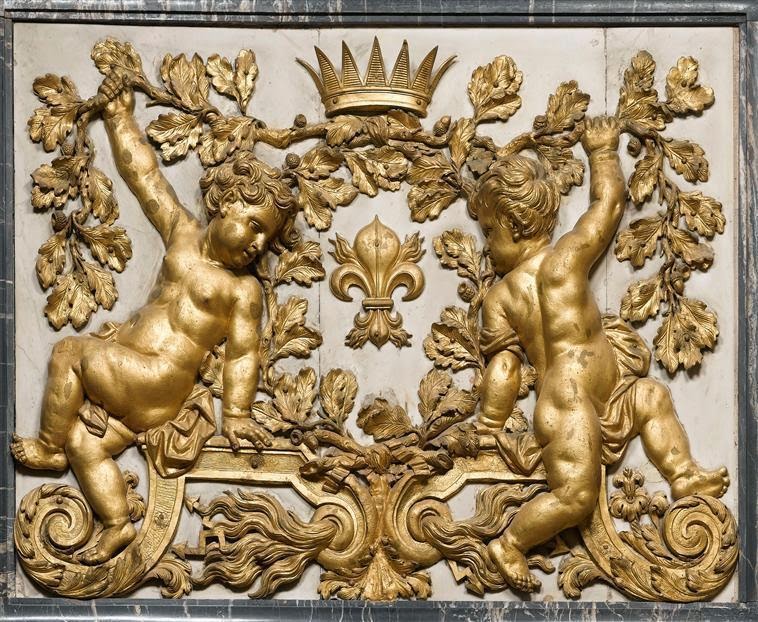1840's Paris porcelain vase from my collection with a scene of Barry's most famous rescue
At the age if fifteen I bought a damage 1840's Rococo Revival style Old Paris porcelain vase with a beautiful Romantic painting of a dog affectionately licking a boy on the face, with a man off to the side peering at them in a wooded landscape. I paid fourteen dollars for the broken vase thinking the attractive hundred and fifty year old miniature painting on it was worth the price in the condition the vase was in. I had pick up the vase in a dusty Old junk shop in the French Quarter that is still open today. Over the years I have bought wonderful items from this shop. The owner originally from New York city, picking over every market, garage sale, and estate sale with a fine tooth comb both in New York and New Orleans, Two great 19th century American city's for finding neat old stuff. He finds some of the most interesting items for his customers at affordable prices.
I often wondered what the story was behind the mysterious handpainted scene on my vase. As I got older I replaced by collection of damaged Old Paris porcelain from my teen days with a large collection of Museum quality Paris porcelain. The dog vase was one of the few pieces I kelp because of the interesting painting. Over the years I have seen over fifty pieces of Paris porcelain dating from the first half of the 19th century that have very much similar painted scenes of a dog, boy and man making this a popular subject on French porcelain and other decorative arts. I'm sure the scene on my vase is from a engraving after a painting but I have not been able to find the source. I now know that the scene depicts Barry the dog with one of his most famous rescues.
A drawing of Barry, preserved at the Natural History Museum of Bern prior to the modifications conducted in 1923.
Barry the dog was born the year 1800 in Switzerland. Named Barry der Menschenretter, he worked as a mountain rescue dog in Switzerland for the Great St Bernard Hospice. Although Barry would be called a St. Bernard dog today, he predates the modern St. Bernard, and was lighter built than the modern breed. He has been described as the most famous St. Bernard, as he was credited with saving more than 40 lives during his lifetime. Barry's most famous rescue was that of a young boy. He found the child asleep in a cavern of ice. After warming up the boy's body sufficiently by licking him, and persuaded the boy to climb on his back, and then carried the boy to safety back to the hospice. The child survived and was returned to his parents
The best of dogs, the best of animals is Barry. You used to leave the convent with a basket round your neck, into the storm, in the most insidious snow. Each and every day you examined the mountain searching for unfortunates buried under avalanches. You dug them out and brought them back to life by yourself and, when you couldn't, you rushed back to the convent signalling the monks for help. You resurrected people. Your tenderness was so easy to communicate, that the boy you dug out had no fear to let you bring him, holding on to your back, to the Hospice.
—Peter Scheitlin, Complete Study on Animal Instinct
Antique French Empire ormolu automaton clock of the dog Barry.
Unusual French Empire automaton clock depicting the famous rescue of a young boy by Barrie. The dog died in 1814 and this clock is dated 1816. Very fine quality case with original fire/mercury gilding. 8 day bell striking movement with silk suspension. The automaton outside bell strikes on the hour and half.
After twelve years of service at the monastery, Barry was brought by a monk to Bern, Switzerland so that he could live out the rest of his life. He passed away at the age of 14. His body passed into the hands of the Natural History Museum of Bern. During Barry's lifetime, his breed did not have one specific name. By 1820, six years after his death, Barry was specifically referred to as being an Alpine Mastiff, Following his death and up until 1860 the entire stock were called "Barry hounds" in the Canton of Bern after Barry himself and also called "Saint dogs". It was not until 1865 when the term "St. Bernard" was first used primarily for the breed. Under this name, the St. Bernard has been recognized since 1880 by the Swiss Kennel Club.
Barry the dog 1800-1814
Barry is described as the most famous St. Bernard by the Natural History Museum of Bern. Following his death, his skin was preserved by a taxidermist for the museum, while the rest of his body was buried. In 1923, his body was refurbished by Georg Ruprecht as his coat had become brittle and had broken into over 20 pieces. During the restoration his body was reposed and his skull shape was modified to match the shape of the St. Bernard of that time in a compromise between Ruprecht and the Museum's director. His original head shape was rather flat with a moderate stop, with the modification resulting in a larger head with a more pronounced stop. A monument to Barry is located opposite the entrance to the Cimetière des Chiens pet cemetery in Paris. Dogs are unique among animals in that there is a long and storied history of man's best friend performing heroic, self-sacrificial acts for their human comrades.
Elaborate memorial dedicated to the legendary Barry, located opposite the entrance to the Cimetière des Chiens pet cemetery in Paris.






















No comments:
Post a Comment